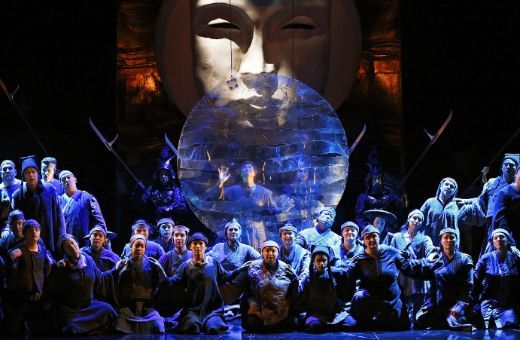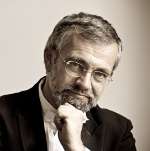After an extensive pandemic-enforced hiatus, Opera Australia opened its 2022 season with barely a week between two sure-fire Puccini revivals, the second of which featured dancer and choreographer Graeme Murphy’s visually stunning 1990 production of Turandot. Stage movement seldom determines the sense of drama to this extent in an opera performance. The swirling crowd scenes – well supported by Kristian Fredrikson’s sets with judiciously used silk banners, vibrant costumes and swaying flags – rightly emphasise the enormous role of the splendid chorus in this opera. They are the people of Peking (“Popolo di Pekino” are the first three words of the opera), here bloodthirsty, there mesmerised by the rising moon, and victoriously cheering the triumph of love in the final scene.

Equally arresting was the opening scene of Act 3, when the frenzy of the whole city, ordered to find out Prince Calaf’s name overnight, is delicately conveyed through wave-like soft materials billowing over the entire stage. Murphy’s razor-sharp sense of timing in the choreography was perhaps best exemplified in the scenes, particularly at the beginning of Act 2, of the three ministers, who provide comic irony and the occasional nostalgic relief against the eponymous princess’s sanguinary demands.
How such an iconic production can maintain its values against the demands of changing times is another question. Today’s audience and the general social discourse may well find the stereotypical portrayal of the Chinese ministers overly caricatured or even offensive, an issue that people rarely commented on 30 years ago. It helps little that the meticulously worked out wealth of winks, smiles and gestures of the ministers in the original production have lost some of their shine (most likely due to different readings of Murphy’s instructions by later revival directors) and, though still entertaining, has become somewhat perfunctory. The sharp precision of every physical movement in this spectacular production was less evident now – the executioners’ swords did not always swing together, and the dancers and their flags often lacked their erstwhile amazing synchronicity.
Next to the chorus, the orchestra plays an equally powerful role in the composer’s last opera, and a fine job it did here. Renato Palumbo conducted his musicians, singers and soloists with empathy and an assured focus. There is probably room for a more impassioned rubato in this music than he used; however, his main goal may have been to keep the large performing forces dependably together, rather than to risk a more flamboyant approach.
The best-known name on the cast list was undoubtedly that of Lise Lindstrom, with apparently over 200 Turandot performances around the world to her credit. Her brief and silent appearance in Act 1 was poignant evidence of Murphy’s directorial eminence. Without any noticeable effort, she demanded attention and respect from her opening “In questa reggia” and conquered her high notes with steely assurance (at times, sounding overly steely). However, her transformation through love from haughty princess to a caring woman in Act 3 – an often-problematic issue for the director, and coincidentally the scene that the composer did not finish due to his death – was sensitively sung. Both she and Yonghoon Lee, the performance's Calaf, reached their most tender moments of the night there.
Lee and fellow South Korean soprano Karah Son (Liù) shared beautiful tonal qualities but poor diction in the Italian text. Lee’s singing was impressive in tone and strength, although his acting needs to gain more expression to match his other qualities. Liù is the uncrowned princess of this opera, and her sacrifice and humanity was tenderly demonstrated by her aria “Signore, ascolta”. Bringing out the gentle human element was also a strength in the ministers’ trio of Virgilio Marino (Pong), Iain Henderson (Pang) and Luke Gabbedy (Ping), even if keeping their vocal ensemble together caused occasional problems.
David Parkin performed the blind, aging Timur with compassion and a resonant bass timbre with perhaps a touch too much vibrato. Both parts of the Prince of Persia and the Emperor were sung by Dean Bassett. Excellent in the former role, his tone as Emperor should carry the unique qualities of a “vecchio decrepito” (a weary voice) according to Puccini, rather than a very soft one, and there is a difference.
Credit is due to Opera Australia for bringing together such substantial forces in order to perform a magnificent late Romantic opera in our extremely trying times. The audience clearly valued this effort; as Ping touchingly explains in Act 2, dreaming about the beautiful past (his cottage at the blue lake) can give a welcome relief from the realities and trepidations of the present.


